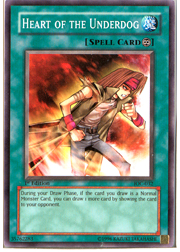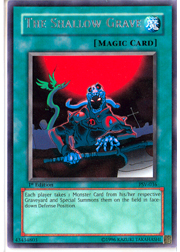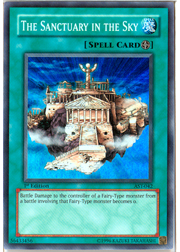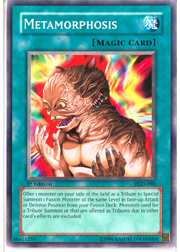Before we look at today’s deck, there’s a pile of responses from the Exodia and Cyberpunk decks that I’d like to go through.
Starting off with the Exodia deck, Dave Smith has a question.
 The build that I've been looking at most uses Heart of the Underdog. Does it sound like an idea that is too far-fetched?
The build that I've been looking at most uses Heart of the Underdog. Does it sound like an idea that is too far-fetched?
The Heart of the Underdog/All-Normal Monster build of Exodia was popular for a while. This was after the release of Invasion of Chaos and during the rush to find One-Turn Kill decks that could outrace Chaos. Eventually this configuration was abandoned in favor of quicker Exodia victories, such as those provided by the Gearfried/Butterfly Dagger – Elma/Royal Magical Library combo or the Manticore of Darkness loop.
The real problem with the Heart of the Underdog build is that it’s incredibly unstable. If you don’t get Heart of the Underdog in your first six cards, you’re sunk. If you do get it and it gets removed by Dust Tornado before you get the chance to use it, you’re sunk. If you add cards like Reload to help smooth your draws, you risk making Heart of the Underdog fail in its mission to roll through your deck, and if you use effect monsters other than Exodia the Forbidden One, you also run the same risk. So, yes, I do think Heart of the Underdog is a bit too far-fetched for this deck.
An anonymous tipster also has something to say about Exodia.
If you really play the stall angle for Exodia, Des Lacooda works great with its flip-up-and-down and draw effect. You’ll have to keep it alive, but if you do, it can draw several cards for you.
This is quite true. Des Lacooda is an excellent card to have in Stall Exodia decks. A few other good cards to try in a deck like this are Dark Mimic LV1 and Dekoichi the Battlechanted Locomotive. As a note, the latter is actually starting to see a fair amount of play in many decks.
Mike looks at another angle of Cyber-Stein OTK.
Because of Book of Taiyou’s speed-flipping, I think Summoner of Illusions deserves a couple of spaces in the deck. Actually, I believe its ability to search out fusions in this deck makes it better than Cyber Dragon.
This would be an excellent idea . . . if it weren’t for the clause in the effect of Summoner of Illusions, which states that you cannot use the Summoner itself as the tribute for its effect. If this was possible, we wouldn’t necessarily need Cyber-Stein, now would we? The tokens generated by Scapegoat are another excellent source of tribute bait for the Summoner, but unfortunately it’s impossible to use both Scapegoat and the effect Summoner of Illusionsin the same turn. This makes Summoner of Illusions unfit for a deck that tries to win on its very first turn.
 Something else I noticed was that many readers didn’t seem to understand why I didn’t include Mind Control in the deck, but that I dedicated three full spots to The Shallow Grave when it’s one of the less useful cards in the arsenal. The answer to the Mind Control question is that I simply forgot to take it into consideration when I was building the deck, focusing instead on dropping a Cyber Dragon to deal with the opposing monster rather than just stealing it for the turn and not bothering with any of the nasty effects that it could have. The Shallow Grave appears in triplicate because the deck was built with a side deck strategy that converts it into a Cookie Jar OTK deck for the second game. After all, you know that your opponent will probably make you go first after game one, so why not take advantage of that with an entirely different combo setup?
Something else I noticed was that many readers didn’t seem to understand why I didn’t include Mind Control in the deck, but that I dedicated three full spots to The Shallow Grave when it’s one of the less useful cards in the arsenal. The answer to the Mind Control question is that I simply forgot to take it into consideration when I was building the deck, focusing instead on dropping a Cyber Dragon to deal with the opposing monster rather than just stealing it for the turn and not bothering with any of the nasty effects that it could have. The Shallow Grave appears in triplicate because the deck was built with a side deck strategy that converts it into a Cookie Jar OTK deck for the second game. After all, you know that your opponent will probably make you go first after game one, so why not take advantage of that with an entirely different combo setup?
As usual, thanks to everyone who wrote in, and while I didn’t get a chance to respond to everyone, I did read everything that was sent. Now, let’s move on to today’s deck!
The Opposite of Burn
One of the first strategies that any new player will usually try out is life gain. They’ll sit there with their Solemn Wishes and Enchanted Javelins and get up to about 11000 life points . . . before the opponent pulls out Heavy Storm, special summons a bunch of monsters, and smashes that obscenely large life total to pieces. After this, the new player will sit there and sulk, wondering how he was able to lose, even though he had more life than you get at the start of the game. Finally, he realizes it—life gain isn’t a win condition!
The problem with most life gain strategies is that they aren’t so much “strategies for winning the game” as they are “strategies for trying not to lose the game.” Fortunately, there’s hope for life gainers everywhere. What if you could do something constructive with all that life you gained? Something like, maybe a massive Burn effect aimed at your opponent’s face? I like this idea. Let’s give it a shot.
“Secret Agent Man”
Monsters: 16
2 The Agent of Judgment – Saturn
2 The Agent of Force – Mars
2 Big Shield Gardna
3 White Magician Pikeru
1 Sinister Serpent
1 D.D. Warrior Lady
3 Shining Angel
1 Sinister Serpent
1 Morphing Jar
Spells: 16
1 Pot of Greed
1 Graceful Charity
1 Premature Burial
3 Scapegoat
2 Metamorphosis
3 The Sanctuary in the Sky
2 Messenger of Peace
2 Level Limit – Area B
1 Lightning Vortex
Traps: 8
1 Divine Wrath
1 Call of the Haunted
1 Mirror Force
1 Ceasefire
1 Ring of Destruction
1 The Spell Absorbing Life
2 Secret Barrel
Fusions: 3
3 Thousand-Eyes Restrict
 This deck is focused around increasing your life point total to two times that of your opponent, then dropping The Sanctuary in the Sky and The Agent of Judgment – Saturn to burn the opponent for the entirety of his or her life points. Failing that, you can summon The Agent of Force – Mars with an ATK and DEF equal to the difference between your life points and theirs and have it rampage through the field. Heck, you can hit it with Ring of Destruction to win the game as well, and your opponent can’t even use Book of Moon to stop it, because The Agent of Force – Mars is immune to spell cards.
This deck is focused around increasing your life point total to two times that of your opponent, then dropping The Sanctuary in the Sky and The Agent of Judgment – Saturn to burn the opponent for the entirety of his or her life points. Failing that, you can summon The Agent of Force – Mars with an ATK and DEF equal to the difference between your life points and theirs and have it rampage through the field. Heck, you can hit it with Ring of Destruction to win the game as well, and your opponent can’t even use Book of Moon to stop it, because The Agent of Force – Mars is immune to spell cards.
As a quick note, if you’re wondering where I’m finding these cards, all the Agent cards and The Sanctuary in the Sky are from the Ancient Sanctuary set, which is known to most players as “That one with the Enemy Controller and Night Assailant.” It’s also home to Spell Economics, Protector of the Sanctuary, and a lot of other excellent cards. My personal favorite “Card That No One Uses” from the set is the normal rare Special Hurricane. This little gem is great for knocking off Sheep tokens, Thousand-Eyes Restrict, Black Luster Soldier – Envoy of the Beginning, and many more. If you’ve got one of these stashed in back of your trade binder, give it a try sometime.
When playing this deck, your first goal should be to clog your own field with White Magician Pikeru and four other monsters. This can be easily accomplished by setting Shining Angel and Scapegoat on your first turn. Barring any opposing copies of Nobleman of Crossout, there’s a good chance that your opponent will attack the Angel, allowing you to fetch Pikeru. If it survives until the end of the turn, activate Scapegoat during your draw phase to start gaining 2000 life points per turn. The problem is that your opponent will probably be doing everything in his or her power to kill off all the monsters you summon, starting with Pikeru.
The easiest way to stop this from happening is to stop your opponent from attacking you. To aid you in this task, the deck includes two copies of both Messenger of Peace and Level Limit – Area B. Level Limit is especially good in this deck because of its synergy with your two copies of Big Shield Gardna. As long as you’ve got Level Limit – Area B in play, Big Shield Gardna will remain in defense position, regardless of how many times your opponent attacks it.
Joining your stall cards are the classic defensive cards Scapegoat, Mirror Force and Ring of Destruction. I shouldn’t have to tell you how good two of these cards are, but in case you didn’t know, Ring of Destruction is the best monster-removing trap in the game. It has no activation conditions, it takes out any face-up monster, and it deals some burn damage. Mirror Force is Mirror Force, and Scapegoat is a quick four-for-one that furthers your strategy.
 The final piece of your “Trifecta of Stall-itude” is Metamorphosis. Just like most of the big-name decks these days, you can easily Morph a Sheep token into Thousand-Eyes Restrict in order to lock down the field. However, unlike the big-name decks, you’ll have no intention of flipping it down. You just want to leave it out there as long as possible so it can work its magic on the field.
The final piece of your “Trifecta of Stall-itude” is Metamorphosis. Just like most of the big-name decks these days, you can easily Morph a Sheep token into Thousand-Eyes Restrict in order to lock down the field. However, unlike the big-name decks, you’ll have no intention of flipping it down. You just want to leave it out there as long as possible so it can work its magic on the field.
The next thing to examine is exactly how you’re going to create this massive difference between your life points and your opponent’s life points. There’s plenty of life gain with the copies of White Magician Pikeru, and joining it is the life-gain version of Ceasefire, The Spell Absorbing Life. I was going to use two copies of The Spell Absorbing Life, but quite frankly, the difference that Ceasefire provides (100 points per monster) is just too useful to pass up. From my experience playing this deck, 100 points is often the difference between a clean win and hoping you draw another burn card within the next couple turns, so make use of Ceasefire as much as possible. I’m also using two copies of Secret Barrel, because while they aren’t actually life gain cards, they do help increase the life point gap. Remember, you’re going to be stalling a lot, so your opponent will probably have plenty of cards to fuel Secret Barrel.
Many people who have seen me play this deck have asked why I don’t use Solemn Wishes. The reason is that I don’t want to have to wait through my opponent’s turns in order to get the differential I need to win the game. Solemn Wishes makes the game take longer, and as the length of the game increases, so does the chance that my opponent will draw the answers he needs to beat me. When it comes time to win the game, just drop The Sanctuary in the Sky if you haven’t already, then tribute for The Agent of Judgment – Saturn and retain priority to activate its effect. Since Saturn is off the field when its effect resolves, Skill Drain can’t stop it, and you can even activate the effect multiple times in one turn if you need to—as long as you have the cards required to revive Saturn for another round of Judgment.
Obviously, this deck can encounter some serious problems. Des Wombat is a big one, as it’s impossible for you to win the game while the Furry One is on the field. Barrel Behind the Door is also a pain, but that card hasn’t seen much play lately. It can be relatively safe to assume that your opponent won’t have it. Monster effects, such as those of Tribe-Infecting Virus or Black Luster Soldier – Envoy of the Beginning, can be a real pain in the neck, so I’ve included one main deck copy of Divine Wrath to deal with some of the random effects that you might run into while playing this deck. Finally, mass removal spells and traps tend to stop you in your tracks, but there isn’t much that you can do about them without including many specialized counter traps to neutralize them—and you can’t play Solemn Judgment, because it completely defeats the purpose of gaining all that life.
Overall, this is a fun deck suited for the kitchen table when you’re playing with your friends. You could try to play it in a serious tournament, but you’d probably just end up getting frustrated. I know, because I tried it. If you’re looking for something fun to do with those cards from Ancient Sanctuary that you never even look at, feel free to toss this deck together and give it a shot. If you really like it, you could even try to tweak it for standard tournament play. If you do, please drop me a line at jcmchale@andrew.cmu.edu and tell me how it goes. As usual, I’ll take the best comments and post them at the start of my next article. Finally, I hope everyone who was at Gen Con Indy enjoyed themselves. I know I did. Until next time, play hard, play fair, and most importantly, have fun!
—Jerome McHale
NEXT WEEK: Watch in amazement as I try to win the game without ever keeping a monster on the field!